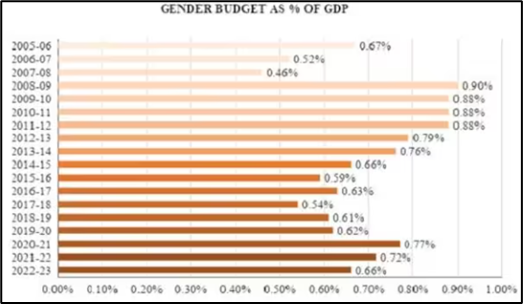Why in News?
- India's Gender Budget, which aims to reduce the gender gap, was allocated ₹2.23 lakh crore in the Union Budget 2023-24, which is just 2.12% higher than the Revised Estimates (RE) of ₹2.18 lakh crore for 2022-23.
- However, it was at least 30% higher compared to last year's Budget Estimates (BE) of 1.71 lakh crore.
What’s in Today’s Article?
- What is Gender Budgeting?
- What is the Timeline of Gender Budgeting in India?
- What are the Issues with Gender Budgeting in India?
- What needs to be Done to Promote Gender Budgeting?
- News Summary with respect to the Recent Gender Budget Announcements
What is Gender Budgeting?
- The Ministry of Women and Child Development (MoWCD) defines gender budgeting as a tool to achieve gender mainstreaming so as to ensure that the benefits of development reach women as much as men.
- The government publishes a Gender Budget Statement (GBS) every year along with the Union Budget.
- GBS is a reporting mechanism for ministries/departments to review their programmes from a gender perspective and present information on allocations for women.
- As such, it is not a separate accounting exercise but an ongoing process of keeping a gender perspective in policy/programme formulation, its implementation and review.
- So, it entails the dissection of the government budgets -
- To establish its gender differential impacts and
- To ensure that gender commitments are translated into budgetary commitments.
What is the Timeline of Gender Budgeting in India?
- 2001: Then Finance Minister of India, in his Budget speech, makes a special reference. National Institute of Public Finance and Policy (NIPFP) analyses the Union Budget 2001-02 from a gender perspective for the first time.
- In 2005-06, The Gender Budget was first introduced, when the Expenditure Division of the Ministry of Finance issued a note on gender budgeting as a part of the Budget Circular.
- Part A of the note reflects Women Specific Schemes, which have 100% allocation for women.
- Part B of the note reflects Pro-Women's Schemes, where at least 30% of the allocation is for women.
- In 2007, the Department of Expenditure issued a charter outlining the composition of Gender Budgeting Cells (GBCs) and their functions.
- In 2010, the Planning Commission clarified that in place of the Women Component Plan, the Ministry of Finance and MoWCD should adopt Gender Responsive Budgeting or Gender Budgeting only.
- Gender budgeting in states: In 2021, the MoWCD stated that 27 states/UTs had adopted Gender Budgeting.
What are the Issues with Gender Budgeting in India?
- Quantum of gender budgeting and fiscal marksmanship: India's gender Budget remains in the range of 4 - 6% of the total expenditure and less than 1% of its GDP. It also lacks fiscal marksmanship, which is the accuracy of budgetary forecasting.
- Concentrated in 5 key ministries: Around 90% of gender budgeting is concentrated in five ministries. When it comes to livelihood, MGNREGA is the biggest scheme in gender budgeting.
- Areas like transportation, water collection and water security remain ignored.
- Post-Covid-19 approach: The last Budget failed to address critical areas highlighted by pandemic in 2021-22 and 2022-23, despite the disproportionate impact of Covid-19 on women.

What needs to be Done to Promote Gender Budgeting?
- Applying a gender lens to Budget: Nobody is saying that make exclusive schemes, but include a gender perspective to government schemes uniformly.
- Track gender disaggregated data: To determine who is benefiting from government schemes.
- Decentralisation: Empowering officials at district level and panchayat level who deal with ground realities on a day-to-day basis.
News Summary with respect to the Recent Gender Budget Announcements:
- Overview:
- There was a 0.63% rise in the share of the Gender Budget in government's total expenditure.
- The estimated Gender Budget stood at 96% of the total expenditure this year, compared to 4.33% last year.
- The gender budget has been an average of 4.9% of the total expenditure as per budget estimates during the previous 15 years.
- Decoding Part A and B of Gender Budget:
- There was a whopping 228% hike in Part A of the Gender Budget compared to last year, while Part B saw a 6% drop from 2022-23.
- Part A of the Gender Budget, which was allotted over ₹88,000 crore this year, is dominated by the Pradhan Mantri Awas Yojana (both Urban and Rural housing).
- Part B - the bigger of the two components - received ₹1.35 lakh crore in the 2023 Budget. Part B comprises several schemes pertaining to rural development, health, education and women empowerment.
- Allocations to key schemes:
- Safe City Project, an initiative under the Nirbhaya Fund scheme for ensuring safety of women and children, saw an eight-fold increase in allocation - from ₹165 crore in RE 2022-23 to ₹1,300 crore in BE 2023-24.
- SAMBAL, a sub-scheme comprising old schemes like One Stop Centre, Women Helpline and Beti Bachao Beti Padhao, saw no change in allocation in the 2023 Budget - ₹562 crore.
- Another sub-scheme SAMARTHYA, which includes women empowerment programmes like Pradhan Mantri Matru Vandana Yojana and Swadhar Greh, was earmarked ₹2,496 crore this year, 33% more compared to RE 2022-23.
- SAMBAL and SAMARTHYA are part of the larger umbrella scheme 'Mission Shakti', an integrated women empowerment programme that came into effect in 2022.










